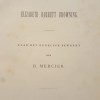
Sasha Dovzhyk, “The Queer Little Grove: The Adoption of Aubrey Beardsley by Mikhail Kuzmin”
This article explores one of the many aspects of Aubrey Beardsley’s (1872–1898) transnational legacy, focusing on his appropriation by Mikhail Kuzmin (1872–1936), a key modernist writer and a seminal voice of the emerging homosexual subculture in Russia. While Kuzmin often used Beardsley as a signifier of homoeroticism in his literary works and life-writing, it is in his play Little Grove (1922) that the queering of Beardsley is crystallized. My intermedial analysis of the piece will show how allusions to Beardsley shape Kuzmin’s representation of gender and sexuality and how the formal construction of Kuzmin’s publication echoes the formal features of Beardsley’s graphic designs.

Karen Dieleman, “Aurora Leigh in the Netherlands, 1870-1900″
Elizabeth Barrett Browning’s 1857 verse-novel Aurora Leigh entered the cultural and social-political life of the Netherlands in the 1870s and 1880s through the work of three Dutch people: a literary critic, a social reformer, and a novelist. Conrad Busken Huet, the country’s leading literary and cultural critic, first brought the poem to Dutch attention in 1873 by showcasing it as a model of great art with high social and moral purpose, from which Dutch contemporary poetry could learn. Hélène Mercier, one of the leading social reformers of the country, then translated the poem into Dutch in 1883 to inspire the country’s social reform efforts. Its prophetic voice, Mercier declared, spoke as directly to the social conditions of the Netherlands in the 1880s as it had to those of England in the 1850s. Arguing that it was not necessary to retain Aurora Leigh’s poetic form for this voice to have effect, she translated the poem as prose. But Dutch novelist Martina van Walcheren did not agree. She produced a poetic translation in 1885 that her publisher supported at least in part because he opposed the emerging art-for-art’s sake movement. All these literary, social reformist, and aesthetic developments or debates were also fueled or complicated by national and international book economies and copyright questions.

Stephen Arata, “On E. W. Lane’s Edition of The Arabian Nights’ Entertainments, 1838″
The sequence of tales called in Arabic Alf Layla wa Layla was introduced to European readers by way of Antoine Galland’s enormously popular twelve-volume edition of Les mille et une nuits (1704-17). English translations of portions of Galland’s edition appear as early as 1706, and tales designated as belonging to the Arabian Nights circulated in close to one hundred separate editions published in Great Britain before 1800, all of them derived in some way from Galland. Galland had drawn from numerous sources—oral, manuscript, and print—and the provenance of many of the tales he translated was murky at best. The first efforts to produce a definitive Arabic edition of Alf Layla wa Layla date to the first quarter of the nineteenth century. Lane presented his edition as the first in English to be based on the recent Arabic editions rather than on Galland. Lane also took the unconventional view that The Arabian Nights were to be read not for their literary or entertainment value but for the historical and ethnographic light they throw on Arabic, specifically Egyptian, “life and customs and manners.” His copious and often quite lengthy annotations of the tales and his modernized system of transliteration, as well as his unapologetic pedantry, impressed and alienated his first readers in about equal measure.
